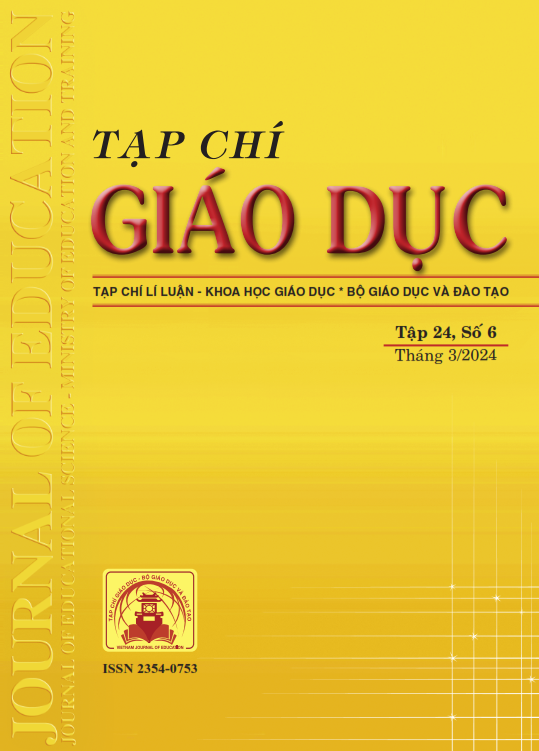Nghiên cứu chủ đề đọc viết ở giai đoạn mầm non tại các nước đang phát triển trên cơ sở dữ liệu Scopus trong giai đoạn 1994-2021: xu hướng và hợp tác quốc tế
Tóm tắt
Early literacy is an important activity in children's language development. This article aims to explore growth patterns and research trends on the topic of early childhood literacy in developing countries. The bibliometric analysis method based on VOSviewer software was used to conduct a review of 261 research publications published from 1994 to 2021 in the Scopus database. Research shows a consistent year-on-year increase in research on the topic, mainly reflected in scientific articles. In addition to the conventional research collaborations with the participation of countries such as the US, Canada and China, new partnerships have emerged, especially in developing regions such as South Africa, Southern American and Southeast Asian countries. The research results can serve as a basis for proposing solutions to develop literacy skills at the preschool stage, helping to improve literacy rates and education quality in developing countries in particular and around the world overall.
Tài liệu tham khảo
Bornmann, L. (2017). Measuring impact in research evaluations: A thorough discussion of methods for, effects of and problems with impact measurements. Higher Education, 73(5), 775-787. https://doi.org/10.1007/s10734-016-9995-x
Cardoso-Martins, C., & Pennington, B. F. (2004). The relationship between phoneme awareness and rapid serial naming skills and literacy acquisition: The role of developmental period and reading ability. Scientific Studies of Reading, 8(1), 27-52. https://doi.org/10.1207/s1532799xssr0801_3
Cobo, M. J., López‐Herrera, A. G., Herrera‐Viedma, E., & Herrera, F. (2011). Science mapping software tools: Review, analysis, and cooperative study among tools. Journal of the American Society for Information Science and Technology, 62(7), 1382-1402. https://doi.org/10.1002/asi.21525
De Jong, M. T., & Bus, A. G. (2002). Quality of book-reading matters for emergent readers: An experiment with the same book in a regular or electronic format. Journal of Educational Psychology, 94(1), 145-155. https://doi.org/10.1037/0022-0663.94.1.145
De Jong, P. F., & Leseman, P. (2001). Lasting effects of home literacy on reading achievement in school. Journal of School Psychology, 39(5), 389-414. https://doi.org/10.1016/s0022-4405(01)00080-2
Đinh Hồng Thái (2013). Giáo trình Phát triển ngôn ngữ tuổi mầm non. NXB Đại học Sư phạm. Hallinger, P., & Chatpinyakoop, C. (2019). A bibliometric review of research on higher education for sustainable development, 1998-2018. Sustainability, 11(8), 2401. https://doi.org/10.3390/su11082401
Irwin, J. R., Moore, D. L., Tornatore, L. A., & Fowler, A. E. (2012). Promoting emerging language and literacy during storytime. Children & Libraries, 10(2), 20.
Kakouris, A., & Georgiadis, P. (2016). Analyzing entrepreneurship education: A bibliometric survey pattern. Journal of Global Entrepreneurship Research, 6(1), 6. https://doi.org/10.1186/s40497-016-0046-y
Kamerman, S. B. (2006). A Global history of early childhood education and care. UNESCO. Kuhl, P. K. (2011). Early Language Learning and Literacy: Neuroscience Implications for Education. Mind, Brain, and Education, 5(3), 128-142. https://doi.org/10.1111/j.1751-228x.2011.01121.x
McCardle, P., Cooper, J., Houle, G. R., Karp, N., & Paul‐Brown, D. (2001). Emergent and Early Literacy: Current Status and Research Directions - Introduction. Learning Disabilities Research and Practice, 16(4), 183-185. https://doi.org/10.1111/0938-8982.t01-1-00018
Murris, K. (2016). Philosophy with children as part of the solution to the early literacy education crisis in South Africa. European Early Childhood Education Research Journal, 24(5), 652-667. https://doi.org/10.1080/1350293X.2014.970856
Nguyễn Thị Thu Hà (2022). Quan điểm tiếp cận năng lực trong xây dựng Chương trình Giáo dục mầm non. Tạp chí Khoa học Giáo dục Việt Nam, 18, 64-70.
Poe, M. D., Burchinal, M. R., & Roberts, J. E. (2004). Early language and the development of children’s reading skills. Journal of School Psychology, 42(4), 315-332.
Rvachew, S., & Savage, R. (2006). Preschool foundations of early reading acquisition. Paediatrics and Child Health, 11(9), 589-593. https://doi.org/10.1093/pch/11.9.589
Sailors, M., Orellana, P., Stortz, R., & Sellers, T. (2019). Exploring urban print environments: A comparative study across San Antonio and Santiago and implications for early childhood literacy practices. Literacy, 53(2), 102- 111. https://doi.org/10.1111/LIT.12161
UNESCO (1990). World Declaration on Education for All. Paris: UNESCO.
UNESCO (2000). Dakar Framework for Action: Education for All. World Forum on Education, Dakar, Senegal.
UNESCO (2003). Literacy as Freedom: A UNESCO Round-table. Paris: UNESCO.
UNESCO (2016). UNESCO: Building peace in the minds of men and women. http://www.unesco.org/new/en/education/themes/ education-building-blocks/literacy/
UNICEF (2019). Only a third of 10-year-olds globally are estimated to be able to read and understand a simple written story. https://www.unicef.org/bulgaria/en/press-releases/unicef-only-third-10-year-olds-globally-are-estimated-be-able-read-and-understand
Wagner, D. A. (2017). Children’s reading in low‐income countries. The Reading Teacher, 71(2), 127-133. https://doi.org/10.1002/trtr.1621
Wanless, S. B., McClelland, M. M., Lan, X., Son, S.-H., Cameron, C. E., Morrison, F. J., Chen, F.-M., Chen, J.-L., Li, S., & Lee, K. (2013). Gender differences in behavioral regulation in four societies: The United States, Taiwan, South Korea, and China. Early Childhood Research Quarterly, 28(3), 621-633. https://doi.org/10.1016/j.ecresq.2013.04.002
Zuilkowski, S. S., McCoy, D. C., Jonason, C., & Dowd, A. J. (2019). Relationships Among Home Literacy Behaviors, Materials, Socioeconomic Status, and Early Literacy Outcomes Across 14 Low- and Middle-Income Countries. Journal of Cross-Cultural Psychology, 50(4), 539-555. https://doi.org/10.1177/0022022119837363
Zupic, I., & Čater, T. (2015). Bibliometric Methods in Management and Organization. Organizational Research Methods, 18(3), 429-472. https://doi.org/10.1177/1094428114562629
Tải xuống
Đã Xuất bản
Cách trích dẫn
Số
Chuyên mục
Giấy phép

Tác phẩm này được cấp phép theo Ghi nhận tác giả của Creative Commons Giấy phép quốc tế 4.0 .












